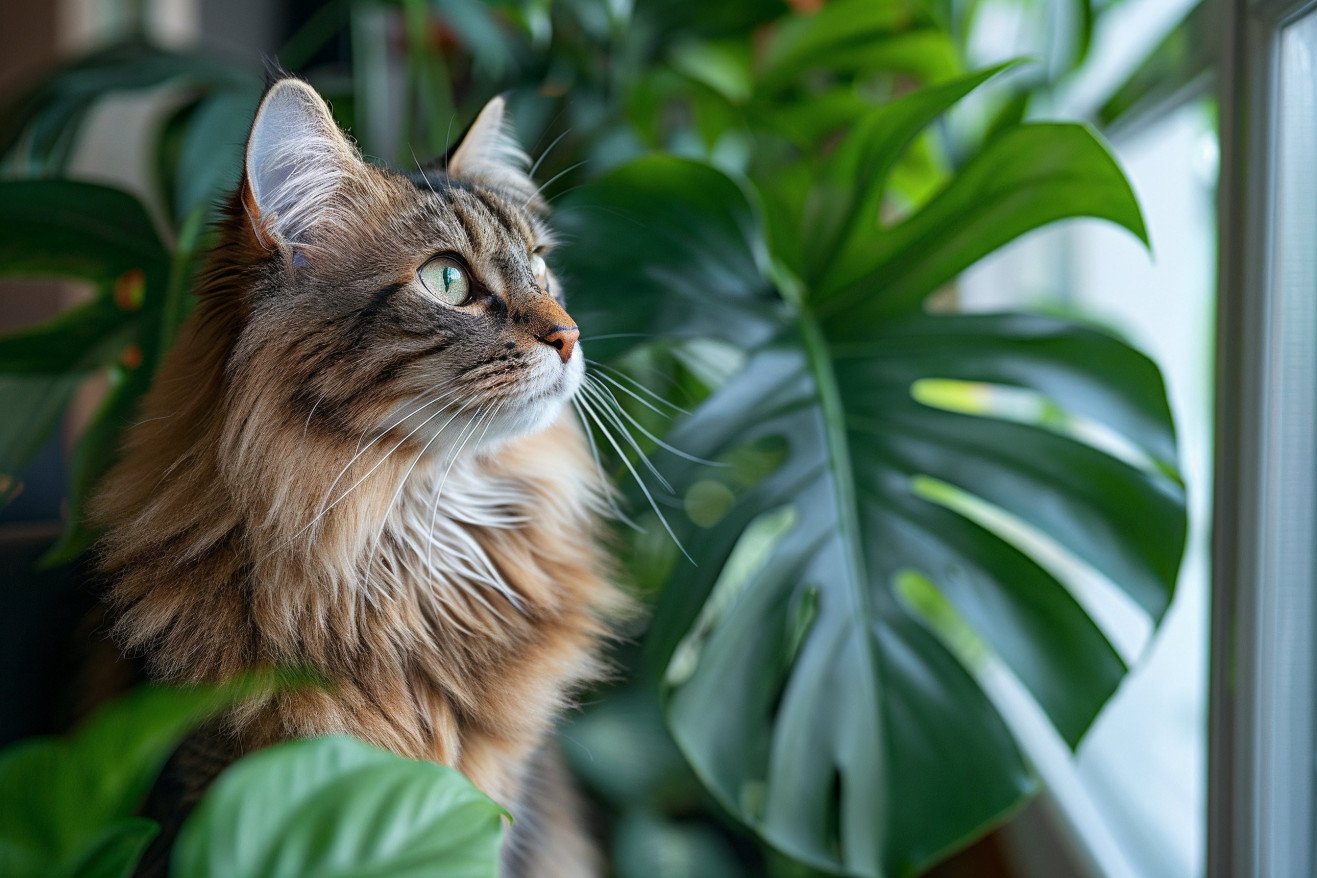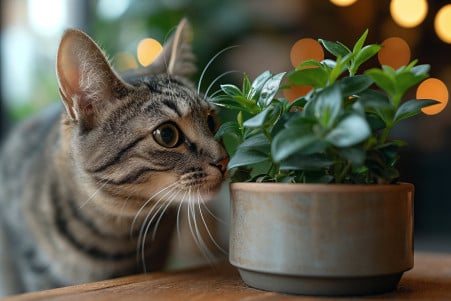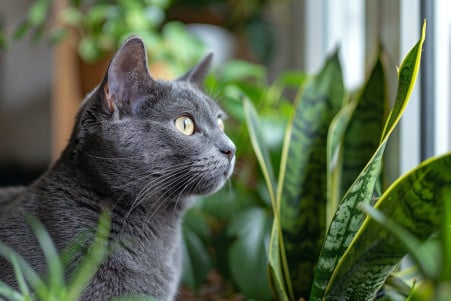Do Monstera Plants Hurt Cats? What to Know About Indoor Hazards
9 February 2024 • Updated 8 February 2024

Monstera plants’ big, beautiful leaves can make a lovely addition to your home, but could they also be a danger to your cat? It turns out that Monstera plants are toxic to cats. They contain calcium oxalate crystals that can lead to oral irritation, drooling, vomiting, and difficulty swallowing.
If a cat has eaten part of a Monstera plant, it’s important to take them to the vet immediately so that they can receive proper care and treatment.
In order to protect our furry friends, this article will cover the botanical and veterinary research that has been done on Monstera plants and their toxicity to cats. It will also discuss the biological impact of calcium oxalate crystals, the signs of toxicity, and important steps that can be taken to prevent cats from being exposed to Monstera plants.
Finally, the article will discuss the bigger picture of plant safety in the home, making sure that pet parents have the knowledge they need to keep their animals safe and healthy.
Are Monstera plants toxic to cats?
Understanding the Dangers of Calcium Oxalate in Plants
Calcium oxalate is a natural compound that plants create to protect themselves from being eaten by herbivores. This is why plants like the beautiful yet dangerous Monstera have insoluble, needle-shaped crystals of calcium oxalate.
When cats eat these plants, the crystals cause mechanical injury by piercing the tissue in the mouth and throat, leading to pain and inflammation. A report from VETgirl Veterinary CE Podcasts notes that clinical signs of poisoning from these plants can include hypersalivation, pawing at the mouth, and vomiting.
The level of toxicity that results from calcium oxalate crystals is dependent on a number of factors, including the amount of the plant that was eaten and the concentration of oxalate in the plant.
As noted in research published on PubMed by Dr. M. M. Rahman, non-ruminants, like cats, are more susceptible to oxalate poisoning than ruminants, which have rumen bacteria that can break down oxalate.
As explained by Vetlexicon Felis, in the most severe cases, pharyngeal swelling can lead to respiratory distress and even life-threatening conditions. Knowing this, it’s important for pet parents to understand the toxicity so they can be aware of the immediate dangers and know how to best protect their cats.
Immediate Action After Your Cat Eats Monstera
If your cat has eaten part of a Monstera plant, it’s important to act quickly. Symptoms of Monstera poisoning in cats include oral irritation, excessive drool, vomiting, and difficulty swallowing.
According to the RSPCA’s cat poisoning advice, it’s important to act fast and get your cat away from the plant. PetMD also suggests that you should look for and carefully remove any plant pieces from your cat’s mouth or fur to prevent re-ingestion.
It’s also important to take a sample of the Monstera plant with you to the vet. This can help speed up the diagnosis by ensuring that the plant is correctly identified. In cases of suspected poisoning, the Pet Poison Helpline or Animal Poison Control should be contacted immediately for professional help.
The experts will give you detailed instructions and will likely tell you to seek emergency veterinary care. By quickly identifying these symptoms and taking action, you are setting yourself up for the next important steps: getting professional veterinary care and helping your cat recover.
Getting Your Cat the Right Veterinary Treatment for Monstera Poisoning
When you arrive at the vet’s office, the vet will first perform a clinical assessment to confirm Monstera poisoning. This will include a physical exam and a discussion of the symptoms you’ve seen.
According to the ASPCA, confirming that the cat ingested the plant through plant identification is important for determining the best course of treatment. The main focus will be on stabilizing the cat and treating the symptoms, which may involve decontamination to remove any remaining plant material from the mouth.
Treatment will also typically involve pain management, anti-inflammatory drugs to reduce the swelling in the mouth and throat, and supportive care like IV fluids if the cat is dehydrated from vomiting or drooling. Cats Protection also notes that it’s important to make sure the cat is closely monitored during the recovery period, as early medical intervention can make a big difference in the outcome.
The recovery period can be different for every cat, but many cats will recover fully with treatment and won’t have any long-term effects.
That said, it’s important to make sure that the cat receives the right aftercare, which will involve monitoring for delayed symptoms and making sure that the cat’s environment is safe.
By making sure that the cat has a safe space that’s free of Monstera plants and keeping an eye on the cat’s health and behavior after the recovery period, you can help make sure that the cat has a smooth recovery and is able to get back to normal.
How to Protect Your Cat from Monstera Plants
In order to keep your cat safe, you will need to take steps to make sure that your cat can’t come into contact with Monstera plants. According to Houseplant Central, you can keep your cat away from these plants by putting them in places that your cat can’t get to, like high shelves or rooms that your cat doesn’t have access to.
The Wildest also suggests using behavioral deterrents like citrus peels or vinegar sprays, which have strong smells that cats don’t like.
You may also want to consider replacing your Monstera with non-toxic plants that your cat can safely chew on. Plants like spider plants, Boston ferns, and parlor palms can give you the greenery you want without the danger to your pets.
According to Greg.app, you can also create a more stimulating environment for your cat by adding cat-friendly plants like catnip or silver vine to your home. This can help redirect your cat’s attention from dangerous plants and give them the interaction with plants that they crave.
By learning about the plants that you have in your home, you are taking an important step in making sure that your cat is safe. By choosing safe plants and taking steps to make sure that your cat can’t access toxic plants, you can make sure that your indoor garden stays beautiful and your cat stays healthy.
Keeping Your Cat Safe While Living With Houseplants
Poisoning from houseplants is a real concern for pet parents, and cats are especially at risk due to their inquisitive nature. One study published on PubMed found that plant poisonings made up 5.7% of the more than 2,000 cases of pet poisoning that were called into a poison control center over a 12-year period, and 26% of these cases were in cats.
Monstera toxicity due to insoluble calcium oxalates is one of the most common plant poisonings in cats, and it can lead to oral irritation and gastrointestinal upset.
That said, Monstera isn’t the only plant that poses a danger. Lilies, for example, are known to cause acute renal failure in cats, according to ScienceDirect.
While the effects of Monstera on cats may not be as dangerous as the nephrotoxicity of lilies, it’s still a common plant that pet parents need to be aware of. This makes it important for cat parents to be aware of the dangers of the plants in their homes and to make sure their cats can’t get to any plants that are known to be toxic.
By learning about the dangers of Monstera and other popular houseplants, pet parents can take steps to make sure their cats are safe and healthy in their non-toxic homes.
How to Keep Your Cat Safe While Living in a Jungle
As discussed in this article, Monstera plants are dangerous to cats because of the calcium oxalate crystals they contain, even though they are beautiful plants. These crystals can lead to oral irritation, drooling, difficulty swallowing, and vomiting and diarrhea, as noted by professionals. The best way to avoid these symptoms is to be diligent about keeping Monstera plants away from cats and choosing other, cat-safe plants to bring into the home.
If you suspect your cat has ingested any part of a Monstera plant, it is important to act quickly. Contacting a vet immediately can help ensure that your cat gets the care they need to avoid any serious side effects.
Hepper and other resources can help you know what to do, which can help you feel more confident and make sure that you are doing everything you can to help your cat.
It’s also important to stay up-to-date on pet safety and plant toxicity, as suggested by A-Z Animals, to make sure that you are protecting your pets from other common toxic houseplants.
By being mindful of the plants you bring into your home, you can make sure that your home is a safe place for your cat. This way, you can enjoy the benefits of having plants in your home while also giving your cat the freedom to explore their indoor jungle.


